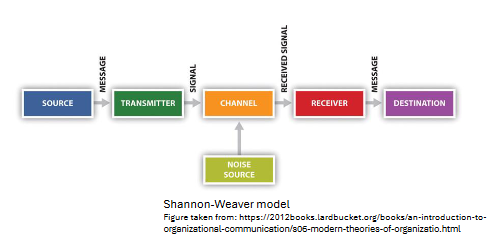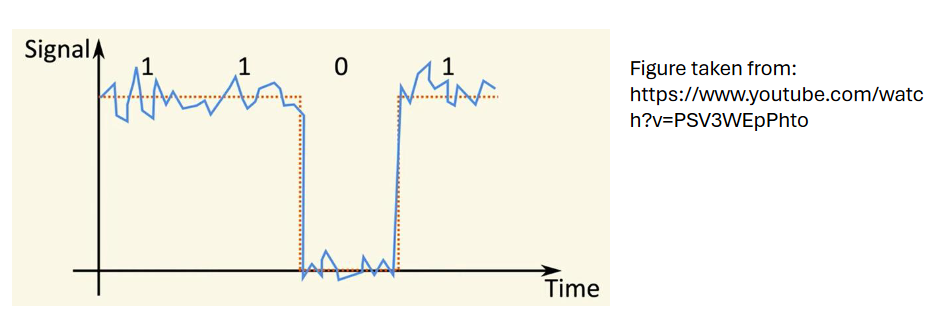Brief introduction to communication
Shannon-Weaver model
The basic concept of communication can be represented by the Shannon-Weaver model. The idea is that communication is a linear one-way process, involving six elements: The source of information, the transmitter that sends a signal to the channel (affected by noise); the signal reaches the receiver which delivers the information to the destination.

Analog vs Digital signals
Analog signals are continuous signals varying with time: the signal (S) is generated by encoding the message (T a time-varying quantity) in some time-varying signal and sent to the receiver. The signal (S) is decoded in order to obtain some information about the original message (T) The two main problems with analog signals are the susceptibility to noise and the difficulty to copy them.
Instead digital signals are generated by encoding a discrete set of values, the accuracy depends on the sampling rate and they show more advantages compared to the analog ones: are less affected by noise, cheaper to produce, easier to process and the bandwidth is easier to manage.
The classical unit for a digital signal is called “bit” and follows the usual representation of 0/1. This notation generally is the representation of an electrical signal with two possible values; even introducing some noise the bit is more robust compared to an analog signal.

Quantum communication
Quantum mechanics offers both superposition and entanglement to exploit in new communication systems. To have a better understanding on notations and representations of qubits that will be used in the following notes, is recommended to look at:
- Bloch sphere: Condensed Matter lecture about qubits
- Dirac notation: Formulas from QMPI
- Gates: Q Electronics introductive lecture
Measurements
A measurement extracts information from a qubit, basically tells us if the qubit is in the state
Measurement in the Pauli Z basis
Considering the measurement as a big box, fed with the prepared state, a general one could be
 Quantum Communications, M. Hajdusek and R.Van Meter
Quantum Communications, M. Hajdusek and R.Van Meter
This particular measurement is referred as measurement in the computational basis or in the Pauli Z basis.
Measurement in the Pauli X basis
The measurement can be done in other basis, like the X basis, looking at the probability of finding the qubit either in state
With

Like before, the measurement collapses the qubit’s state either in
Basis and inner product
From linear algebra: a basis is a set of vectors that allows you to write down any other vector.
The generic state
An important concept is the inner product, is basically a dot product between two vectors and tells us the “overlapping” between two quantum states. A bra is needed for the product, and is defined as the adjoint of a given state
The inner product between
The state is normalized when
The inner product can be used to calculate the probabilities of different outcomes when measuring the state in a particular basis.
Probabilities
The measurement of a qubit is a single shot measurement; in order to obtain some information about the probabilities, many measurements should be performed on copies of the same state.
In the case of the box mentioned above of the measurement in the Z basis the number of outcomes "
Expectation value
In the Pauli Z basis:
in Dirac’s notation:
Variance
The outputs of the measurements are random, some degree of variance is expected:
Thus in the Pauli Z operator is:
Multiple Qubits
Two classical bits can be in four different states:
Using Dirac’s notation:
Any general state of two qubits can be written as a superposition of those four possible states, weighted by their respective probability amplitudes
The state
In vector notation these kets are:
We can easily see that are orthogonal to each other, and that they form a basis for the space of the two-qubits states, the general superposition in vector notation is:
Tensor Product
The tensor product is the mathematical concept that allows us to construct the vector representation of the two qubits given the states of the individual ones. The symbol that denotes the tensor product is
or equivalently:
Noise
A new formalism is needed to consider the effects of noise in quantum communications or noise in the state preparation.
Outer product
The outer product is defined as:
